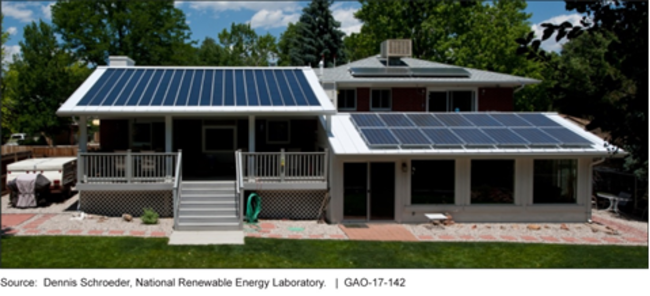Electricity: Status of Residential Deployment of Solar and Other Technologies and Potential Benefits and Challenges
Fast Facts
Rooftop solar panels, batteries, and smart thermostats, installed in residences, can allow customers to generate and store electricity, as well as manage its use. These and other technologies can make electricity grids operate more efficiently and provide other benefits—such as cleaner generation of electricity.
However, if deployed without regard to grid conditions, these technologies could present challenges—for example, too much customer-generated power could exceed local grid capacity and lead to higher infrastructure costs.
State and federal policymakers are considering ways to mitigate these challenges and maximize benefits.
Residential Rooftop Solar System

Photo of solar panels on a house.
Highlights
What GAO Found
Federal and state policymakers have used a range of policies to encourage the deployment of solar systems and other technologies that allow residential customers to generate, store, and manage their electricity consumption. For example, federal tax incentives—such as the investment tax credit—have reduced customers' up-front costs of installing solar systems. In addition, a Department of Energy funded database of renewable energy incentives identifies 41 states with net metering policies that require electricity suppliers to credit customers for electricity sent from their solar systems to the grid, providing an additional incentive. Moreover, in 14 states, customers can also receive state tax credits for installing solar systems, according to the database, which further reduces the up-front costs.
According to GAO's analysis of Energy Information Administration (EIA) data, deployment of solar systems has increased significantly in some states, with the total number of residential customers with solar systems increasing sevenfold from 2010 to 2015. However, customers with solar systems represent a very small portion of overall electricity customers—about 0.7 percent of U.S. residential customers in 2015, according to EIA data. Every state experienced growth in the number of customers with residential solar systems, although certain states, such as California and Hawaii, accounted for most of the growth and have had more widespread deployment. For example, about 14 percent of residences in Hawaii have installed a solar system, according to EIA data. Although comprehensive data on the deployment of electricity storage systems and smart devices are not available, the data and information provided by stakeholders GAO interviewed suggest their deployment is limited.
The increasing residential deployment of solar systems and other technologies poses potential benefits and challenges, and some policymakers have implemented or are considering measures to address these, as GAO found in its analysis of reports and stakeholder interviews. Specifically, these technologies can provide potential benefits through more efficient grid operation, for example, if customers use these technologies to reduce their consumption of electricity from the grid during periods of high demand. Nonetheless, grid operators GAO interviewed said they have begun to confront grid management and other challenges in some areas as solar deployment increases. For example, in some areas of Hawaii, solar systems have generated more electricity than the grid was built to handle, which resulted in the need for infrastructure upgrades in these areas. However, grid operators reported that challenges generally have been manageable because overall residential solar deployment has been low. Policymakers in some states have implemented or are considering measures to maximize potential benefits and mitigate potential challenges associated with the increasing deployment of these technologies. For example, two states' regulators have required electricity suppliers to identify areas of the grid where solar and other technologies would be most beneficial to grid operation. In addition, several state regulators recently have allowed electricity suppliers to adopt voluntary time-based electricity prices that increase when demand for electricity is high, providing customers with an incentive to reduce consumption at these times, potentially by using solar, storage, and other technologies.
Why GAO Did This Study
Traditionally, electricity has moved in one direction—from electricity suppliers to customers. Today, solar systems allow electricity to be generated at a customer's home and sent to the grid for electricity suppliers to use to meet other customers' electricity needs. Storage systems allow residential customers to store electricity from the grid or their own solar system for use at a later time. Furthermore, customers can use smart devices, such as thermostats, to manage their electricity consumption.
GAO was asked to provide information on the deployment and use of technologies that give customers the ability to generate, store, and manage electricity. This report describes (1) key federal and state policies used to encourage the deployment of these technologies, (2) the extent to which these technologies are being deployed, and (3) the benefits and challenges of deploying these technologies. GAO analyzed available data on technology deployment from EIA and reviewed relevant reports and regulatory documents. GAO interviewed a non-generalizable sample of 46 government agencies and stakeholder organizations. This sample included state regulators and at least one electricity supplier from each of five states: Arizona, California, Hawaii, Minnesota, and New York, which were selected based on state policies and having high levels of technology deployment.
GAO is not making recommendations in this report.
For more information, contact Frank Rusco at (202) 512-3841 or ruscof@gao.gov.
